Becoming a "Manga Studies" Hub in Japan at Kumamoto University!

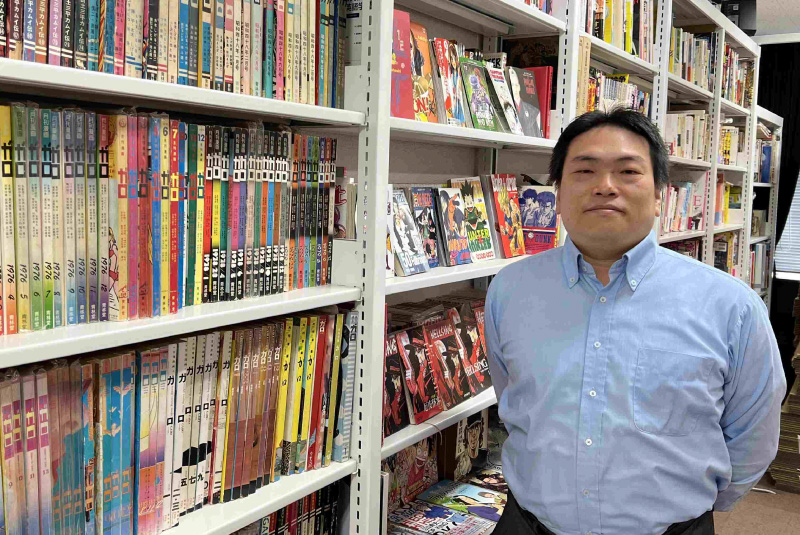
Dr. Yoshihiro IKEGAWA, Associate Professor
International Research Center for Manga Studies
Faculty of Humanities and Social Sciences
In this issue, we introduce Associate Professor Yoshihiro Ikegawa of the International Research Center for Manga Studies attached to the Faculty of Letters. He has a rather unusual background, having worked as a magazine editor and engaged in national Manga research project. He is dedicated to establishing the center a base for nationwide Manga research and archive projects.
Becoming a "Manga Studies" Hub in Japan at Kumamoto University!
First of all, please tell us how the International Research Center for Manga Studies was established at Kumamoto University.Dr. Ikegawa: Kumamoto Prefecture has produced many famous artists, including Eiichiro Oda, the author of “ONE PIECE”, and launched the “Kumamoto Manga Prefecture” concept about 10 years ago. As part of the move to establish Kumamoto as a “Manga Prefecture” through industry-academia-government collaboration, Faculty of Letter established a course of “Studies in Contemporary Cultural Resources” in Department of Communication and Information Studies, which also includes Manga as a research subject, in 2019. Kumamoto University and Kumamoto Nichinichi Shimbun then launched the “Kumamoto Manga Council”, which was followed by the establishment of the International Research Center for Manga Studies attached to the Faculty of Letters in October 2022. The main role of the Center is to contribute to society through international research in Manga Studies, education through human resource development, and local cultural resources.
One of its missions is to “archive manga publications”. Manga already has a history of nearly 150 years as a printed material, but there are not many facilities that preserve it. Especially in Kyushu, there are no full-scale archiving facilities for Manga in general. This center was established to serve as a center for Manga studies and archiving not only in Kyushu, but throughout Japan. However, this center is too small, so we would like to build an archive facility in a different location.
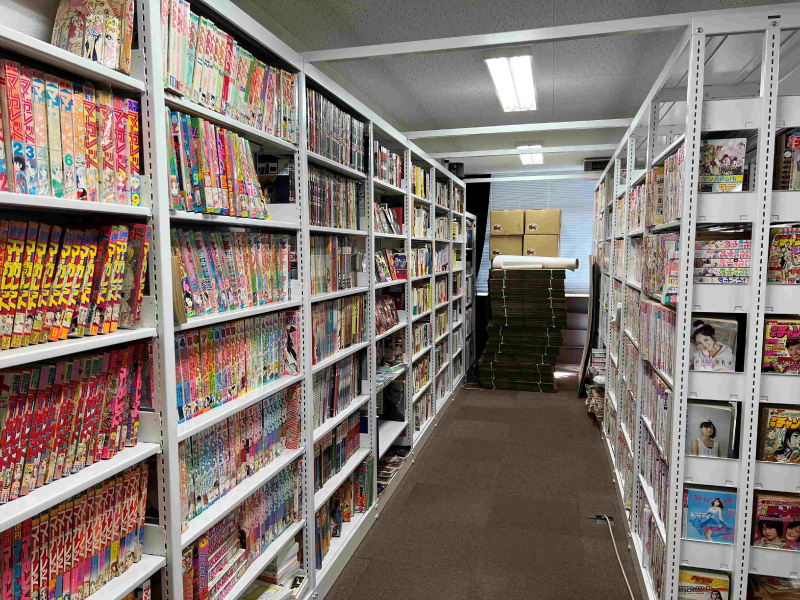
Why is Manga Studies?
Dr. Ikegawa: It is a very interdisciplinary field. For example, if you are interested in the theory of manga works, you can incorporate methods from the study of authors in the literature study, and if you are interested in the readers, such as the kind of people who read manga, you can take a sociological approach to research. I think it is an interesting field of study in that it brings together knowledge from a variety of fields.
What kind of research are you doing?
Dr. Ikegawa: I have somewhat unique career. I have worked as an editor at a publishing company, was involved in a national Manga research project, and worked as a curator. I make use of those backgrounds in my work.
One example is my work to add new value to past masterpieces and introduce them to the public. In fact, there is a long-story manga set in the Fifth High School, the predecessor of Kumamoto University. Kumamoto University is promoting the “Kumamoto University Campus Museum Concept” in which the entire university becomes a museum, centering on the Memorial Museum of the Fifth High School. As part of this plan, we held a special exhibition themed on the manga work "Ah, Goko, Bufugento ni Kusa Moete (あゝ五高 武夫原頭に草萌えて) " by the Manga original writer, Ikki Kajiwara, at the the Memorial Museum of the Fifth High School in the summer of 2023 and at a bookstore in the city center in the fall of the same year.
His grandfather was from Kumamoto, and he himself felt the source of his identity in Kumamoto. Although it is slightly different from the actual situation of the students at the Fifth High School, he has a strong feeling for “Bankara (バンカラ – rough and uncouth vigor, and those who dare to act as such.)” thing, so he dared to depict an ensemble drama set in the Fifth High School. I think this was created with the intention of looking back on himself, rather than aiming for a hit. In Fact, there was also a story that was not included in the book, which fans call the “fantastic first story,” a manga about his visit to Kumamoto at the start of the series, which was shown at the special exhibition. You can also learn about Kumamoto prefecture in 1978, the year his work was published.
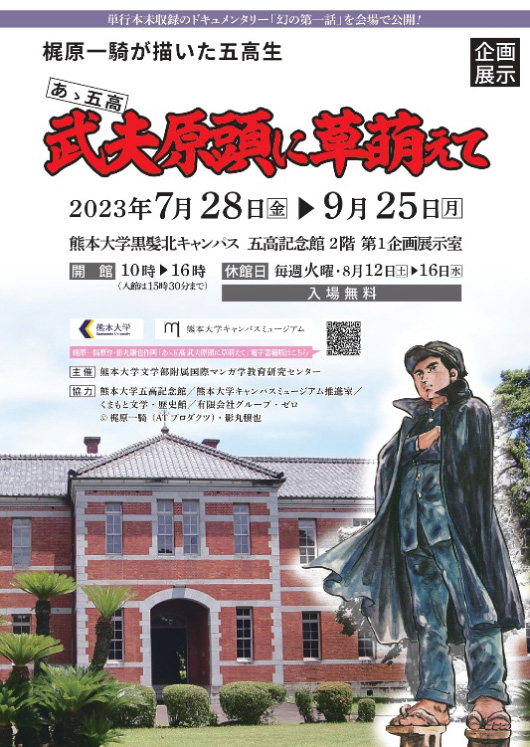
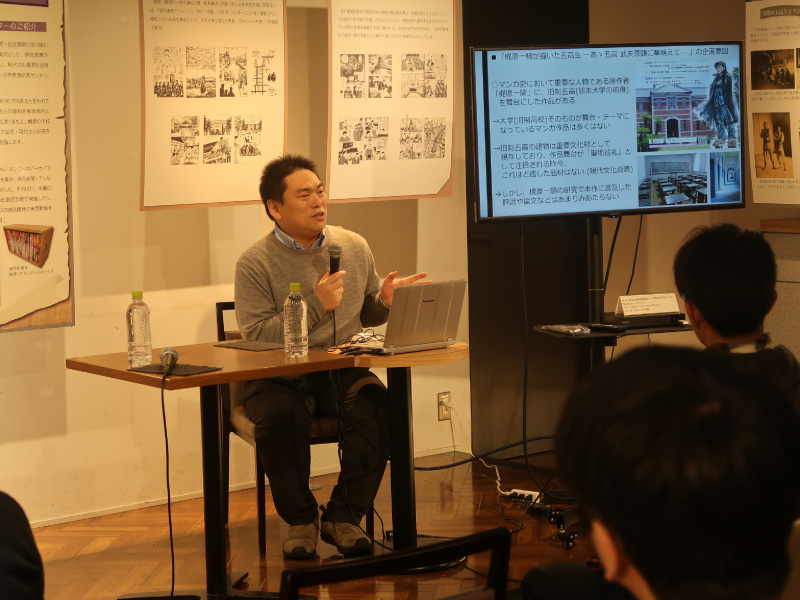
(The talk event at Tsutaya Kumamoto Sannenzaka, a bookstore in city center)
Developed a Box to Store Manga Magazines in Good Condition
You also developed a box for storing Manga magazines.Dr. Ikegawa: Magazines, especially saddle-stitched ones without spines, become squishy and difficult to store when they are standing up. To store them neatly, I developed a “saddle-stitched Manga magazine storage cardboard box” together with BTconnect, a company in Kumamoto, and obtained a utility model patent. One of the main features of this products is that it can be divided into several volumes by the dividing board inside. The size of the cardboard boxes is also well designed so that magazines published twice a month can be stored for a year in one box, and monthly magazines can be stores for two years in a single box.
In libraries, several magazines are stored together in a single file. When this is done, the spine of the magazine is glued. In fact, the spine of the magazine contains information such as the date of publication and the editor’s name, which is very important for research purposes. From an archival standpoint, we developed this system in order to preserve the original appearance of the journal as much as possible. We have already received purchases from universities, research institutes and others.
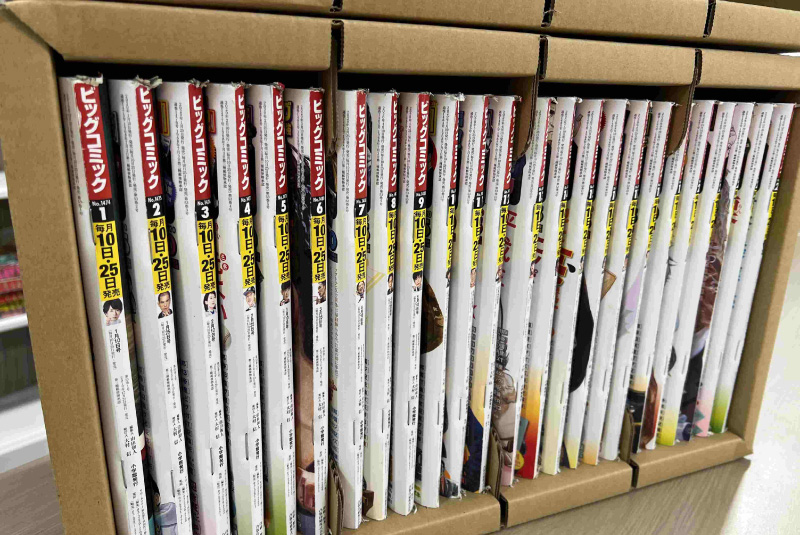
When do you think Manga magazines are particularly important?
Dr. Ikegawa: Manga magazines provide valuable information about how a Manga appeared on the market. For example, if you simply want to read “ONE PIECE,” you can read the book. But let’s have a look on the August 4, 1997 issue (No. 34) of “Weekly Shonen Jump (週刊少年ジャンプ)” in which the first story was published. You will find an article introducing “Purikura (photo sticker booth)” in between the “ONE PIECE”, and a reader’s gift was the first PlayStation, which was very attractive for boys in 1997. You can see that “ONE PIECE” was first published in such a background. I think that Manga magazines are excellent “package of the times” in that they make it easy for today’s students to grasp the atmosphere of the time after 25 years. I think this is my own experience from the standpoint of having actually been creating the magazine.
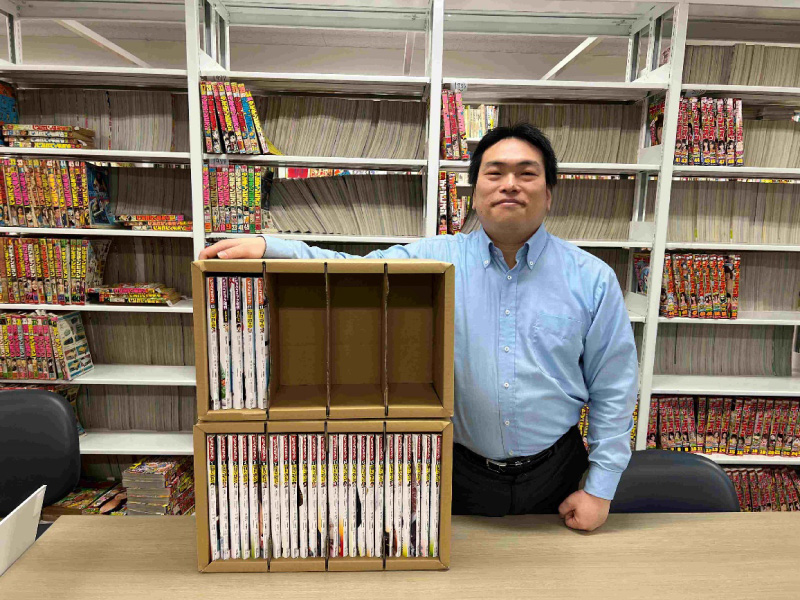
Manga magazines are a treasure trove of diversity. Open the door and dig deep into a world you didn't know existed!
How do your students utilize the Center?
Dr. Ikegawa: We conduct seminars here. Manga studies allows students to find various research approaches on their own. The Center has not only Manga, but also many research books on Manga, which suggest what themes you should focus on what kind of rails you should lay and what kind of stations you should go through to get where you want to go in your research. I think it is easy to get a sense of distance from your research, to say, “This is what I am interested in” or “I can go this far in my research”, and so on.
In this context, I tell them about the advantages of Manga magazines as a “package” for understanding the times and society, which I talked about earlier. I believe that many young people read Manga on apps, but there is a lack of diversity there that Manga magazines used to have. Not only Manga, but the world that students see today is seemingly wider due to the development of the Internet, and the information they are interested is in selectively provided, and is actually very limited in some areas. I would be happy if they could become aware of such things.

Finally, what are your future plans?
Dr. Ikegawa: My own mission is to play a central role in the “Manga Prefecture Kumamoto” concept through industry-academia-government collaboration, and at the same time to make the Center's presence known in areas slightly different from academia, such as the development of products like storage boxes. The secretariat of the Japan Society of Studies for Cartoons and Comics has also relocated to the Center, and we are now working to make it a leading research institution for media art and contemporary culture studies in Japan and overseas.
There are said to be more than 500,000 Manga publications in Japan, and again, the Center's vision is to find a place to archive and store these materials in Kumamoto Prefecture. As an archive facility, it would be great if there is a place where everyone in the prefecture can also browse and provide access to manga magazines and other materials from the past.
Related links:
